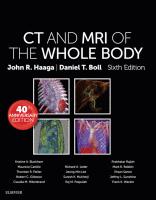Physical Address
304 North Cardinal St.
Dorchester Center, MA 02124

Computed tomography (CT) and magnetic resonance imaging (MRI) have become indispensable for diagnosis, evaluation, and treatment of intracranial infectious disease, contributing to significant decline in morbidity and mortality of these patients. CT is useful as a rapid screening tool to…

Introduction Based on data collected from several central cancer registries during the years 2007-2011, the Central Brain Tumor Registry of the United States (CBTRUS) estimates that 67,900 new cases of primary brain and central nervous system (CNS) tumors will be…

Anatomy of the Brain The advent of high-resolution computed tomography (CT) and magnetic resonance imaging (MRI) scanners has allowed the fine anatomic structure to be seen in detail. In this chapter the gross surface anatomy of the brain is briefly…

Introduction In the evaluation of diffuse and focal liver disorders, magnetic resonance imaging (MRI) has been proven to provide superior characterization of disease processes and therapy outcomes compared to other modalities in the imaging armamentarium. The particular strength of hepatic…

Introduction The demand for pediatric magnetic resonance imaging (MRI) is steadily increasing because MRI is radiation free, has exquisite soft tissue contrast, and provides quantitative structural, functional, and vascular information for diagnosing a wide spectrum of diseases. Furthermore, the advent…

Introduction Contrast agents used in magnetic resonance imaging (MRI) can be either endogenous or exogenous. The most common type of endogenous contrast-enhanced MRI is arterial spin labeling (ASL) techniques, which use a dynamic labeling of internal water to measure brain…

Introduction Magnetic resonance angiography (MRA) enables noninvasive assessment of vascular disease in both the arterial and venous circulation. Owing to the availability of volumetric data sets without the need for ionizing radiation exposure and facilitated by technologic and methodological advances…

Magnetic resonance imaging (MRI) is based on spatially encoding a nuclear magnetic resonance (NMR) signal. Therefore an understanding of the basics of NMR is critical for understanding MRI, and this information is given in the first section of this chapter.…

Protocol Management and Optimization Protocols are the turn-by-turn instructions that allow the computed tomography (CT) operator to get from point A—registering the patient on the scanner from the order in the radiology information system (RIS)—to point B—sending a complete set…

Computed tomography (CT) has grown quickly from an innovative specialized tool to a mainstay of medicine in every healthcare setting. Hospitals, outpatient clinics, and physician offices find CT to be an essential tool for patient diagnosis and management. Every year…